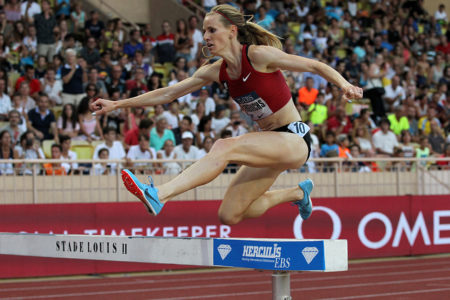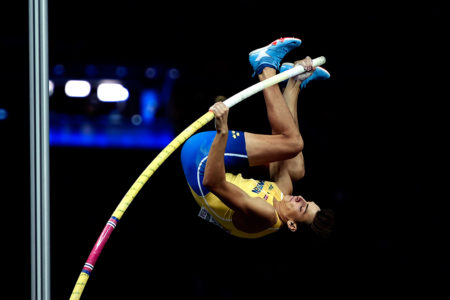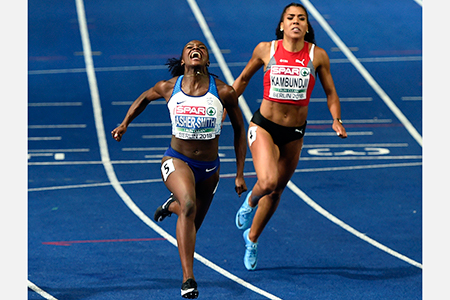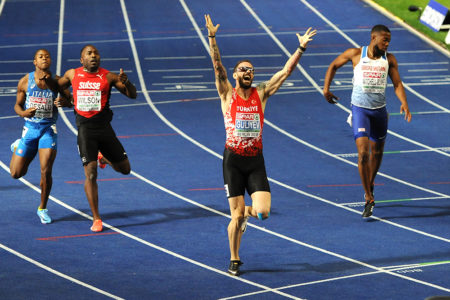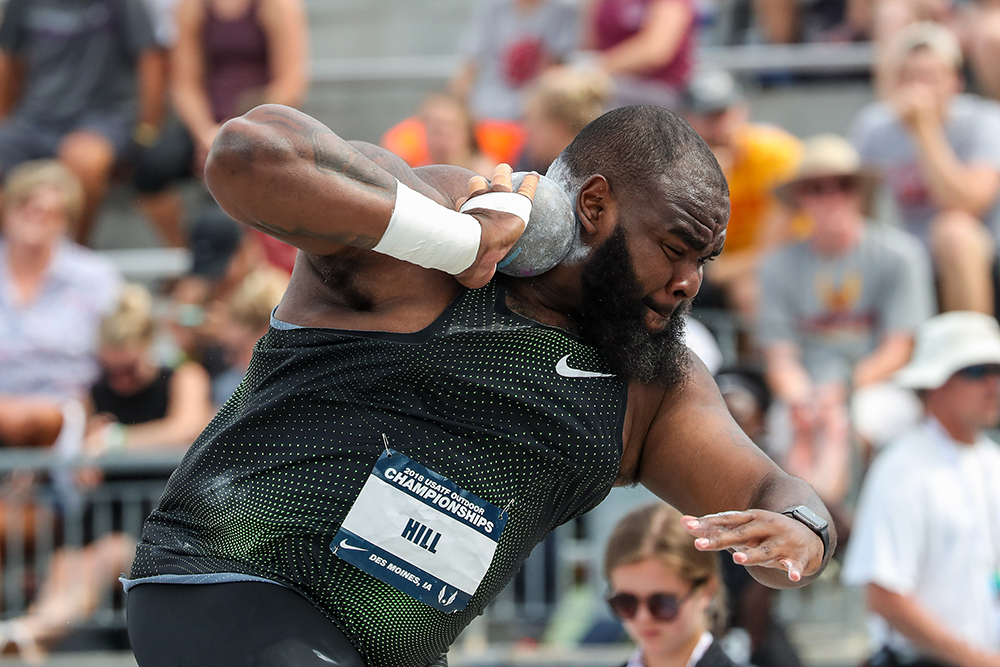
For two years now Darrell Hill, you might say, has been the stealth shot star, the putter who lofts one long when you don’t see it coming.
In ’16 at the Olympic Trials he was the first-year pro who came into a field loaded with four world champions and produced the first 70-footer of his life to make the team. True, that other first-year pro, Ryan Crouser, won with a toss more than 2½ feet longer but Crouser’s pedigree, replete with four NCAA crowns in and out, had him on everybody’s watch list. Hill’s NCAA 2nd in ’15 had not screamed “future Olympian.”
Last year Hill made the World Championships final, placing only 11th, but then he struck again at the Diamond League Final. In a ring set up in Brussels’ imposing Grand Place square, on his final throw Hill flung the ball 73-7½ (22.44) for the win and jumped to No. 8 on the U.S. all-time list. (Continues below)
Hill’s days in sneaking-up-on-’em mode were over, and he underscored that taking his first USATF title in June. “It really wasn’t that anything was working well,” Hill told the media in Des Moines after denying Crouser the chance to be the first putter since Al Feuerbach (1973–75) to win at the nationals 3 years in a row. “It was just trying to be able to stay balanced. It was one of those competitions that it didn’t take a 22-meter throw to win, it was who was going to be able to settle into the competition and be able to just get a good throw.
“70 feet is a great throw, but with these guys—you know I’ve thrown 73-feet, Ryan and Joe [Kovacs] have thrown 74-feet so you know the potential for far throws is there. Today was just a competition where it was the race to 70-feet. Sometimes it’s like that and I’m just glad that it was able to be me today.”
No question, Hill (whose first name is accented Dah-RELL) is operating in a golden age for the iron ball. He knows it. In the last 15 months Tom Walsh (74-4½/22.67), Crouser (74-3¾/22.65) and Kovacs (74-¾/22.57)—all winners of World or Olympic gold—launched their shots into all-time world top 10 territory. Just 3¾ inches away from that list with his PR, age-wise Hill is the baby of the bunch, 24 years old, born 8 months after Crouser.
And Hill’s “throwing age”? Well, in ’09 Crouser PRed at 67-7 (20.60) with the high school 12-pounder and Hill, same prep graduating class (’11), had not yet even picked up a shot for his school, Pennwood of Lansdowne, Pennsylvania. The recent model Hill may be the putter people didn’t see coming. Eight years ago he didn’t even see it himself, although soon enough he would.
The Shot Came Along Late
“When I was in high school I played football, I played AAU basketball, I wrestled for a period of time, I tried a bunch of different things,” he says. “As I got older I loved football and I was progressing in that, and a high school track coach saw me in the hallway my junior year and asked me if I could help the team out. They had a league championships that week and he was just, ‘Hey, we don’t have any shotputters. I know you’re a big guy [he currently scales in at 6-3½/330 [1.92/150], I know you’re strong so do you think you could just come throw this ball for us?’
“A lot of my friends were already on the team so for me it was just I get to get on a bus with my friends, go to a different school, all I gotta do is throw a shot and I get to hang out with my friends. I really liked the coach, he was a nice guy. So I went and did that. I didn’t do anything spectacular. I think I threw 37-feet so that obviously wasn’t anything great but I loved my friends so we had a great time going there, we had a great time at the meet, great time on the way back. And I wasn’t really having that much fun wrestling, to be honest. I wasn’t great, I was just another guy on the wrestling team and so I just decided this was more fun than that. I wasn’t good, I was just having more fun.
“So I quit the wrestling team and decided to keep throwing shot, and just naturally, me being a competitive person, I took to YouTube to really kind of see what this sport was that I was doing and just tried to get better each time out and be competitive with the guys that were around me. Then we went to a meet in New York and I saw Nick Vena, who was a 70-footer at that point of time. So just trying to be competitive with the people that I would see was what kind of helped me develop in high school.”
That meet in New York was the New Balance Indoor Nationals and Hill in his first full season as a putter placed 7th at 60-7¾ (18.48) with the 12-pounder. The heave was the second of his series and he fouled the other five. Not exactly a disaster as he had switched putting styles just weeks before. “I was originally a glider,” he explains. “That’s the easy one to teach somebody. Not all the way, but the easiest way to teach a beginner is to teach him how to glide first. I was a glider all the way until the middle of my senior season. I didn’t really have a throws coach. My head coach, Lenny Jordan, was a sprint coach but if you talked to him he’d tell you he’s not a throws coach at all.
“So I was at a competition and I competed against another guy often and his dad was a throws coach. He came up to me after three throws and said, ‘Hey, do you think you’re going to do this in college?’
“I said, ‘Maybe I might,’ because I’m getting good at that point.
“He said, ‘They’ll probably ask you to spin so why not just give it a shot? You’ve already got this meet won by like 6-feet. Why not just mess around with it?’
“And I’m one to just mess around with stuff so I did and I ended up matching my mark from the first three throws with the glide with the spin. So I decided I was going to stick with that. That was my transition to the spin.” That transition began auspiciously enough that the NBIN mark attracted some attention from college coaches. “There’s not schools beating down your door at 60-feet but you can get some opportunities,” he says. “So I didn’t have any full ride offers but some schools called, they were interested in me and I took a couple visits.”
Keeping in mind Hill’s progression versus putters that are now his peers, consider that Crouser threw 77-2¾ (23.54) that prep indoor season. Different zip code. Then.
Moving On To College
“I went to the University of Houston for my freshman year, H-Town Speed City, as they call it now,” Hill recalls. (Cougar coach Leroy Burrell is a Pennwood alum.) At the West Regional his frosh year, Hill threw 55-1 (16.79). Three weeks later at the USATF Junior Champs he reached 61-1¼ (18.62) with the U20 implement and placed 4th.
“I really enjoyed my time when I was at the University of Houston. I still talk to Coach Burrell, I still talk to my teammates from there, I met a lot of great people there, but I’m a Penn Stater through and through,” Hill says. “I had to make a tough decision to leave Houston, obviously, but I knew that my true happiness would be with me being back at Penn State in the blue and white.”
A Rehabilitation & Human Services major, Hill remembers the exact day in his Nittany Lion putting career that he decided he could be an Olympian. Details matter to him: “It was my junior year at the Big 10 Championships at Purdue University. I had been doing pretty well. My first time that I ever won a Big 10 championship was at that meet. My PR at the time was 19.64 [64-5¼] and in round 6 of the Big 10 Championships I threw 20.57 [67-6], which was my first time over 20-meters and obviously the Olympic standard at 20.50. So it put me over the Olympic standard, it got me an opportunity to go to the U.S. Championships and the NACAC U-23 team that summer. So it was the first real glimpse that, yeah, maybe I could have an opportunity to do this after school.”
Here’s where Hill’s story jumps to his push through the 70-foot barrier and Rio at the next summer’s Olympic Trials. Wait, not so fast.
At the Trials, “it was a breakthrough that I got [the distance] legally,” Hill says, “but all the way back to 2015 at the USA Championships, I was actually leading after round 1. I thought I was going to Beijing. I’m a very confident person so I threw 20.80 [68-3] in 2015 in round 1 and I was feeling really confident and I just had a bunch of heel fouls on the toeboard. I’m bringing them into the ring but I’m clipping the top of the toeboard over and over and over again, and they were about 21.40, 21.30 throws. And I did that all summer. I did it at the Pan-American Games, I did it at my first meet in Europe. I mean I did it all summer so it was very troubling for me that my personal best is 20.86 [68-5¼] but it should realistically probably be about 21.30.”
In the spring of ’16, Hill’s heel-foul problem “drove me to come work with [revered throws coach] Art Venegas at the [Chula Vista] Training Center,” he says. “That was what I called him about: ‘Do you think you could get me to land with my heel flat in the ring so I won’t foul?’ ”
Venegas’s answer: “Absolutely.”
Hill told the coach, “If you can do it, I’m coming.” Recalling his early sessions with Venegas, Hill says his new coach “told me, ‘There’s a ton of things that I want to help you to work on that I think could help you be the best in the world but for these next couple months we’re just gonna work on trying to get your heel flat. That’s the biggest issue.’ And I went 20.94, 21.16, 21.63, and the next thing you know I’m going to the Olympics.
“It wasn’t even so much at that period of time physical. I’ve got to thank my [Penn State] coach Patrick Ebel who’s now at Auburn University. We put a lot of great work in, but technically I just kept getting called on the heel. And it’s not like the officials were wrongly calling it, I just kept hitting the toeboard. So that was kind of a big breakthrough.”
His day of days to that point had come from far enough out of the stratosphere that Hill’s family was nowhere close to tickets-to-Rio-booked status. No money for the air fare was readily at hand. But Hill’s father, Ellis, an Uber driver, says the son, “met a wonderful passenger who wouldn’t take no for an answer. She was just so generous and wanted to help my dad get that opportunity to come watch me compete. So they set up a crowd-funding with a gofundme account and I just posted it just to see. I didn’t know what to feel about it nor what to think but I just posted it and the U.S. kind of just took over with that. A lot of people supported me and supported my dad and that meant the world to me.”
Ellis Hill works in Darby, Pennsylvania. “So if you see my dad as your Uber driver,” Hill says, “give him a good tip.”
While Hill’s best in the Olympic Q round (64-2¼/19.56) didn’t advance him to the final, his path as an elite thrower was set.
“Rio was an experience,” he says. “Training was up and down, I was happy to be there, I was confident. I didn’t, honestly, get the performance that I wanted to but I put that directly back into training. Me and Coach Venegas, that was our first real championship together, and we’d only been together for about 4 months at that point so really understanding championship training and what kind of makes me go and how to make things work, I think we lost that a bit in the details. So that’s what I can attribute my performance in Rio to. It didn’t go my way but I threw far a couple weeks after that [70-4¼/21.44) at the Zagreb IWC] so I was obviously still prepared to do well.”
Last fall the rightly venerated Venegas retired. His legacy hasn’t skipped a beat. This season Hill, still training in Chula Vista, connected with San Diego State throws mentor Greg Garza, whose college coach at UCLA was Venegas.
Garza, Hill says, “knows the background that I have as far as the type of drills and things that I’ve done. So that made the transition a little bit easier into his system. But his system is completely different, he has his own style. He took the knowledge that he got from working with Art and kind of developed his own way. So it definitely was an adjustment—just getting used to a new person. Me and Greg, we didn’t even know each other a year ago. I’d seen him once and we shook hands.” But the collaboration gelled rapidly.
“If you subtract my 22.44 from last year,” Hill assesses 2018, “I’d say I’m having the best year of my life. So, so far so good.” For superb consistency, he is surely right. Through the late-July Diamond League break Hill had put up 10 meets above 21-meters and at least 19 throws at that level, with the shortest of these his 69-½ (21.03) at the Lausanne DL. (Continues below)
“I say this all the time, I say it to anybody who wants to listen: My goal is to be the best ever. And to be the best ever it’s not just one thing. You need gold medals, so my goal is obviously to win the World Championships, the Olympic Games and to throw farther than anybody’s ever thrown. I mean that’s no secret, we all have those same ambitions. But yeah, the World Record. I won’t just say in the next three years but I’m trying. I think I might need it [to win a meet some day]. That’s the beautiful thing about where we are in the sport right now. It’s so tough competing. Every week you got Ryan Crouser, you got Tom Walsh, you got Joe, and you’ve got Michał Haratyk at 22-meters [72-5¼/22.08]. It’s super tough but I believe that we’re going to see the best throwing that we’ve ever seen because of it.
“I’m just really excited to be in the sport at this time right now because—as good as I’m ever gonna be? We’ll find out, we’ll find out soon.” □
